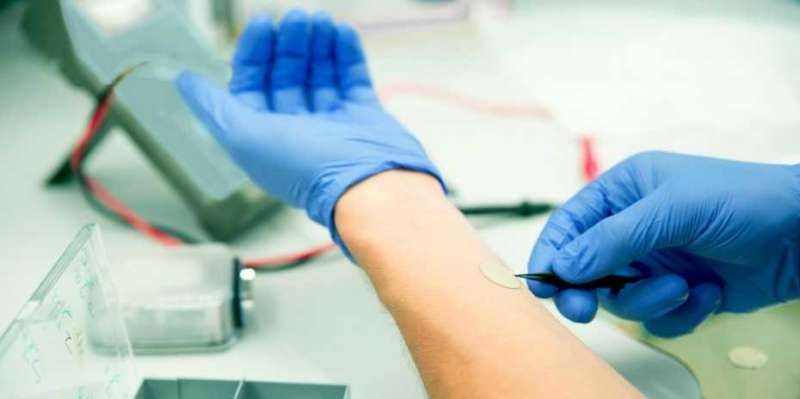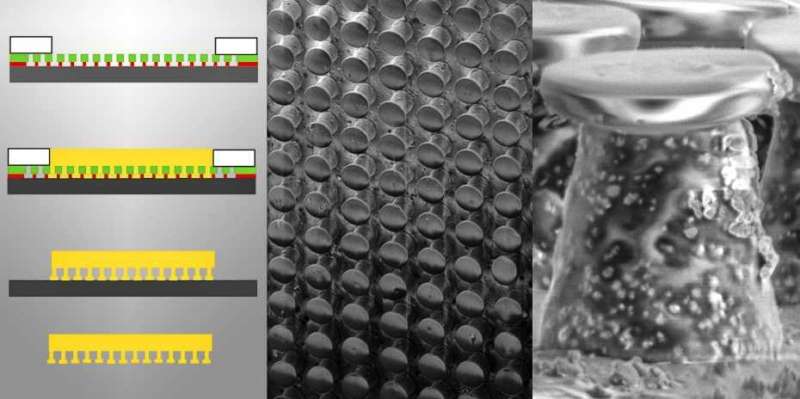Soft material inspired by grasshoppers for better electrode adhesive

Researchers at ETH Zurich have developed a new type of health-monitoring electrode that exhibits optimum adhesion to skin and can record high quality signals. Two young spin-off founders want to turn it into a marketable product as early as this year.
Anyone who has ever had an electrocardiogram – for example, to check their heart fitness – will be familiar with the electrodes that the doctor attaches to the chest. However, the conventional electrode models have considerable disadvantages: hard metallic electrodes are uncomfortable to wear and are not suitable for taking measurements over longer periods. Gel electrodes, the type most commonly used in everyday clinical practice, often cause skin irritation or even allergic reactions in patients.
Now, ETH researchers led by Janos Vörös, Professor of Bioelectronics, and Christopher Hierold, Professor of Micro and Nanosystems, have found a solution. They have developed an electrode that is as elastic as skin, so that it is barely noticeable to the wearer. The special surface structure allows signals from the heart and brain to be recorded in high quality. The researchers recently published details of their work in the journal Advanced Healthcare Materials.
Inspired by nature
For the new electrode, the researchers used a soft material – a non-irritant mixture of silicone rubber and conductive silver particles – that stemmed from an earlier research project by Vörös' group. For the surface structure, the scientists looked to nature for inspiration: they used the mechanism that allows grasshoppers to walk even on vertical surfaces.
The soles of these insects' feet are covered with countless tiny pads, which look like mushroom heads under a microscope and are arranged like a mosaic. When they come into contact with another surface, an adhesive effect occurs, known in technical terms as Van der Waals interaction.
The researchers applied this microstructure to their material, creating an electrode surface that adheres to the skin. In addition, the special geometry at the microscopic level maximises the contact surface between skin and electrode, allowing signals to be recorded in very high quality.

From the cleanroom to the swimming pool
The researchers created the prototypes in a cleanroom using a specially developed fabrication process. They coated a base layer with two different paints and covered it with a precisely perforated mask. Then, they exposed the sample to light, which made the upper light-sensitive paint directly beneath the perforations soluble. Next, they immersed it in a chemical solution that attacked the soluble areas of the upper layer of paint first, before working its way through to the second layer of paint. At this stage, the researchers stopped the degradation process at precisely the right point in order to create the casting mould with nothing but inverted mushroom heads. When cast, this produced a specifically structured adhesive electrode surface.
To check whether the electrodes work even in challenging conditions, the researchers tested them on a swimmer. Due to water resistance and the vigorous movements involved in swimming, this is considered a particularly challenging discipline for performance monitoring by means of electrodes. The results were impressive: the quality of the signals recorded by the new electrodes was significantly better than that of the gel electrodes also worn by the swimmer. In the meantime, Zurich's lake rescue service has already shown interest in the new electrodes and is using them as part of an ongoing study.
Besides electrodes for recording cardiac output curves (electrocardiograms or ECG), the researchers have also developed an electrode for measurement of brain signals, known as electroencephalography (EEG). The material combination is the same for both types of electrode, but the structures differ: the EEG electrodes do not need the adhesive microstructure, as they are attached using a cap. Instead, their surface is equipped with several pimples of two to four millimetres in height that allow contact with the scalp even through thick hair. Thus, shaving and gel are not required.
Next step: industrialisation
Séverine Chardonnens and Simon Bachmann, two of the study's authors, were convinced of the market potential of such electrodes from the outset. Even before completing their Master's degrees, they pushed ahead with the idea of establishing their own company – and they were successful: the two talented young scientists were accepted on to the Venture Kick and CTI funding programmes and have already gained a good deal of seed capital through start-up competitions.
Following the successful development of the prototype electrode and the official founding of IDUN Technologies as an ETH spin-off in November 2017, Chardonnens and Bachmann are now evaluating on which application they should first concentrate. They are engaged in intensive discussions with a variety of industry partners and research groups. "Commercialisation is worthwhile in applications where the new electrodes offer the biggest advantages over existing models," says Bachmann. "We see potential in the long-term monitoring of patients, in sports performance monitoring and in the EEG market."
After the question of strategic orientation has been settled, Chardonnens will focus on the process of industrialisation in her role as head developer, while Bachmann will concentrate primarily on the acquisition of partners and customers in his capacity as CEO. "If everything goes as planned, we will be able to sell the first electrodes as early as this year," says Chardonnens.
More information: Flurin Stauffer et al. Skin Conformal Polymer Electrodes for Clinical ECG and EEG Recordings, Advanced Healthcare Materials (2018). DOI: 10.1002/adhm.201700994
Journal information: Advanced Healthcare Materials
Provided by ETH Zurich



















